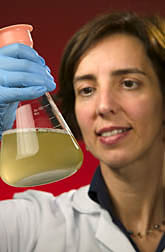|
Read the
magazine
story to find out more. |
|

Microbiologist
Maria Brandl views microscopic Tetrahymenaprotozoa growing in a liquid
medium. Click the image for more information about it.
|
Tiny Animals Aid Salmonella
By Marcia Wood
February 16, 2006
Salmonella, one of the planet's most problematic food-poisoning
bacteria, may have an accidental ally: transparent, nearly invisible animals
called protozoa. Agricultural Research
Service microbiologist
Maria
T. Brandl has provided new evidence of the mostly mysterious interaction
between these microscopic protozoa and Salmonella.
Brandl's discoveries from her work at the agency's
Western
Regional Research Center in Albany, Calif., may lead to new, more powerful,
and more environmentally friendly ways to reduce the incidence of
Salmonella in meat, poultry and fresh produce.
During their lives, Salmonella bacteria may encounter a
commonplace, water-loving protozoan known as a Tetrahymena. Brandl's
laboratory tests showed that the protozoan, after gulping down a species of
Salmonella known as S. enterica, apparently can't digest and
destroy it. So, the Tetrahymena expels the Salmonella, encased in
miniature pouches called food vacuoles.
The encounter may enhance Salmonella's later survival. Brandl
found that twice as many Salmonella cells stayed alive in water if they
were encased in expelled vacuoles than if they were not encased.
|

Research assistant
Aileen Haxo (left) and Maria Brandl examine confocal micrographs of green
fluorescent-labeled Salmonella cells enclosed within food vacuoles of
Tetrahymena protozoa. Click the image for more information
about it.
|
What's more, Brandl found that the encased Salmonella cells
were three times more likely than unenclosed cells to survive exposure to a
10-minute bath of two parts per million of calcium hypochlorite, the bleachlike
compound often used to sanitize food and food-processing equipment.
The research is the first to show that Tetrahymena expel living
S. enterica bacteria encased in food vacuoles and that the
still-encased, expelled bacteria can better resist sanitizing.
Brandl and colleagues Sharon G. Berk of
Tennessee Technological
University-Cookeville and
Benjamin
M. Rosenthal at ARS'
Henry
A. Wallace Beltsville (Md.) Agricultural Research Center documented their
findings in a 2005 issue of Applied and
Environmental Microbiology. Brandl now wants to pinpoint genes that
Salmonella bacteria turn on while inside the vacuoles. Those genes may
be the ones that it activates when invading humans.
Read
more about the research in the February 2006 issue of Agricultural
Research magazine.
ARS is the U.S. Department of
Agriculture's chief scientific research agency.